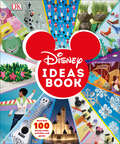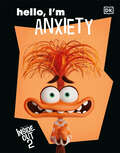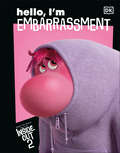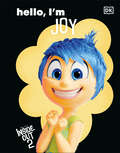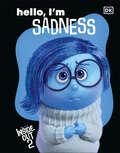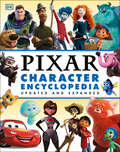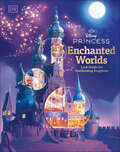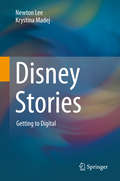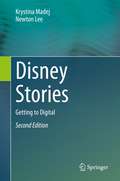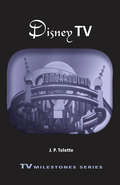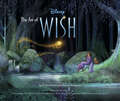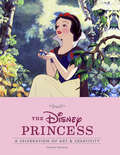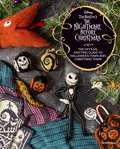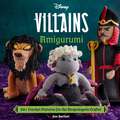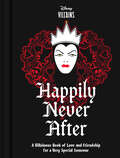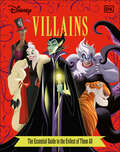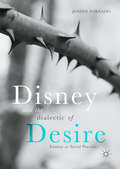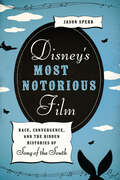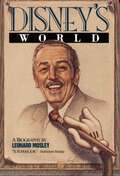- Table View
- List View
Disney Ideas Book: More than 100 Disney Crafts, Activities, and Games
by DK Elizabeth DowsettBring your love of Disney to life with more than 100 amazing and creative projects and activities.The perfect rainy-day gift for kids who love Disney and enjoy crafting. Let their imaginations run wild with more than 100 enchanting Disney inspired arts and crafts, party games, puzzles, papercraft and many more fun and practical activities. With stunning photography and clear step-by-step instructions, the Disney Ideas Book guides you through each exciting project, from growing grass hair on Frozen trolls and creating The Lion King animal masks to crafting festive Mickey Mouse hanging decorations and Winnie the Pooh party hats. There are top tips on every page to help make your creations a success, with handy templates provided at the back of the book. Featuring family favourite characters from animation and live-action movies and TV, including Frozen, Toy Story, Moana, Inside Out and Cinderella.
Disney Inside Out 2 Hello, I'm Anxiety
by DKIntroducing the “Hello” series in collaboration with Disney and Pixar!The stars of Inside Out 2 are here to help kids aged 6-9 engage with and embrace the wide range of human emotions!In Hello, I’m Anxiety, this friendly Inside Out 2 character guides children through an understanding of anxiety, fostering intelligence and self-awareness of these complex but common feelings in a fun and relatable style. Approachable and affirming, this anxiety book for kids is designed to communicate vital topics in a sensitive but authoritative way.Help your kids build a greater awareness and understanding of anxiety:A great conversation starter – An accessible, informative, and uplifting introduction to understanding anxiety, written to empower the next generation.Approachable and child-friendly – Kids are given the freedom to imagine themselves in the pages with a friendly and child-appropriate tone throughout.Perfect for kids ages 6-9 – Throughout the series, Inside Out 2’s well-known and lovable characters serve as narrators and guides, allowing kids the space and comfort to approach these big feelings.This unique collection, inspired by Inside Out 2, offers young readers ages 6-9 an engaging way to explore their emotions through first-person narratives. It’s never too early to tackle these important topics – and the beloved cast of Inside Out 2 makes starting the conversation easier than ever!Discover the “Hello” book series:Hello, I’m AnxietyHello, I'm EmbarrassmentHello, I'm JoyHello, I'm Sadness© 2025 Disney/Pixar
Disney Inside Out 2 Hello, I'm Embarrassment
by DKIntroducing the “Hello” series in collaboration with Disney and Pixar!The stars of Inside Out 2 are here to help kids aged 6-9 engage with and embrace the wide range of human emotions!In Hello, I’m Embarrassment, this friendly Inside Out 2 character guides children through an understanding of embarrassment, fostering intelligence and self-awareness of this complex but common feeling in a fun and relatable style. Approachable and affirming, this mental health book for kids is designed to communicate vital topics in a sensitive but authoritative way.Help your kids build a greater awareness and understanding of embarrassment:A great conversation starter – An accessible, informative, and uplifting introduction to understanding embarrassment, written to empower the next generation.Approachable and child-friendly – Kids are given the freedom to imagine themselves in the pages with a friendly and child-appropriate tone throughout.Perfect for kids ages 6-9 – Throughout the series, Inside Out 2’s well-known and lovable characters serve as narrators and guides, allowing kids the space and comfort to approach these big feelings.This unique collection, inspired by Inside Out 2, offers young readers ages 6-9 an engaging way to explore their emotions through first-person narratives. It’s never too early to tackle these important topics – and the beloved cast of Inside Out 2 makes starting the conversation easier than ever!Discover the “Hello” book series:Hello, I’m AnxietyHello, I'm EmbarrassmentHello, I'm JoyHello, I'm Sadness© 2025 Disney/Pixar
Disney Inside Out 2 Hello, I'm Joy
by DKIntroducing the “Hello” series in collaboration with Disney and Pixar!The stars of Inside Out 2 are here to help kids aged 6-9 engage with and embrace the wide range of human emotions!In Hello, I’m Joy, this friendly Inside Out 2 character guides children through an understanding of joyful feelings, fostering intelligence and self-awareness of these uplifting and interesting feelings in a fun and relatable style. Approachable and affirming, this emotions book for kids is designed to communicate vital topics in a sensitive but authoritative way.Help your kids build a greater awareness and understanding of joy!A great conversation starter – An accessible, informative, and uplifting introduction to understanding joy, written to empower the next generation.Approachable and child-friendly – Kids are given the freedom to imagine themselves in the pages with a friendly and child-appropriate tone throughout.Perfect for kids ages 6-9 – Throughout the series, Inside Out 2’s well-known and lovable characters serve as narrators and guides, allowing kids the space and comfort to approach these big feelings.This unique collection, inspired by Inside Out 2, offers young readers ages 6-9 an engaging way to explore their emotions through first-person narratives. It’s never too early to tackle these important topics – and the beloved cast of Inside Out 2 makes starting the conversation easier than ever!Discover the “Hello” book series:Hello, I’m AnxietyHello, I'm EmbarrassmentHello, I'm JoyHello, I'm Sadness© 2025 Disney/Pixar
Disney Inside Out 2 Hello, I'm Sadness
by DKIntroducing the “Hello” series in collaboration with Disney and Pixar!The stars of Inside Out 2 are here to help kids aged 6-9 engage with and embrace the wide range of human emotions!In Hello, I’m Sadness, this friendly Inside Out 2 character guides children through an understanding of sadness, fostering intelligence and self-awareness of these complex but common feelings in an informative and relatable style. Approachable and affirming, this emotions book for kids is designed to communicate vital topics in a sensitive but authoritative way.Help your kids build a greater awareness and understanding of sadness:A great conversation starter – An accessible, informative, and uplifting introduction to understanding sadness, written to empower the next generation.Approachable and child-friendly – Kids are given the freedom to imagine themselves in the pages with a friendly and child-appropriate tone throughout.Perfect for kids ages 6-9 – Throughout the series, Inside Out 2’s well-known and lovable characters serve as narrators and guides, allowing kids the space and comfort to approach these big feelings.This unique collection, inspired by Inside Out 2, offers young readers ages 6-9 an engaging way to explore their emotions through first-person narratives. It’s never too early to tackle these important topics – and the beloved cast of Inside Out 2 makes starting the conversation easier than ever!Discover the “Hello” book series:Hello, I’m AnxietyHello, I'm EmbarrassmentHello, I'm JoyHello, I'm Sadness© 2025 Disney/Pixar
Disney Pixar Character Encyclopedia Updated and Expanded
by Shari LastDive into the wonderful world of Pixar with the new edition of this bestselling, fan-favourite, fully illustrated, and fact-filled character guide.Now featuring more than 320 characters, this new edition has been updated and expanded to include characters from Pixar's recent releases. Find out more about the greatest and funniest heroes, villains, sidekicks and oddballs from across every Pixar movie, including 2020's Onward and Soul, as well as 2021's box-office hit Luca and 2022's Turning Red and Lightyear.Whether your favourite character is Buzz, Lightning, and Mater along with these more recent ones: Izzy, Sox, Meilin, Joe, 22, Luca, or Giulia, the Pixar Character Encyclopedia lets you relive their top movie moments and latest adventures, discover special "Did you know?" facts, and much, much more.Featuring: - Beautifully illustrated with images from the original movies.- Organised in chronological order from Toy Story to Lightyear; characters from sequels, such as Toy Story 4 included with original movie.- Age-appropriate text for 7-11 year olds.Looking for more information about the Lightfoots, Luca Paguro, and Buzz Lightyear's latest adventures? The new edition of the Pixar Character Encyclopedia is the one-stop book for you!
Disney Princess Enchanted Worlds: Look Inside the Spellbinding Kingdoms
by DKA lavish look inside 13 beautifully detailed castles, buildings, and vehicles from the animated Disney Princess movies.How do you reach the hidden staircase escape route in Rapunzel’s tower? Where is the main stage of the ballroom inside Tiana's restaurant? How many turrets does Snow White’s castle have?From Ariel’s underwater palace to Cinderella’s pumpkin coach and Belle’s castle, explore the hidden treasures and mysteries of your favourite Disney Princesses’ homes, vehicles, and buildings.Featuring all the need-to-know details about the enchanting worlds of the Disney Princesses:Go behind the scenes of all 13 Disney Princesses’ homes and vehicles, with elaborate illustrations that capture each and every detailComplete with pages dedicated to each Disney Princess, including classic characters Ariel, Belle, and Jasmine alongside recent Princesses like Moana and RayaA beautiful gift for Disney fans and fairy tale lovers to cherish and enjoy – with plenty of hidden details to spot, you won’t see all there is to see in just one read!This authoritative cross-sections book takes young Disney fans beyond what’s seen on screen, offering enchanting surprises and a plethora of details to spot. Readers can feast their eyes on beautifully illustrated locations, including magical kingdoms, spellbinding ballrooms, and enchanting libraries.© 2025 Disney
Disney Stories
by Newton Lee Krystina MadejDisney Stories: Getting to Digital explores how Disney, the man and the company, used technological innovation to create characters and stories that engage audiences in many different media, in particular in Video Games and on the Internet. Drawing on Disney films from the twenties and thirties, as well as the writings of historians, screenwriters and producers, Disney Stories: Getting to Digital explains how new film and animation techniques, many developed by Disney, worked together to evolve character and content development and produce entertaining stories that riveted audiences. Through an insider's perspective of Disney's legendary creation process, the book closely examines how the Disney Company moved its stories into the digital world in the 1990s and the virtual, online communities of the 2000s. By embracing the digital era, Disney led storytelling and technological innovation by granting their audience the unique opportunity to take part in their creation process through their online games, including The Lion King Animated Story Book, Disney Blast and Toontown. Disney Stories: Getting to Digital is intended for Disney fans and current practitioners looking to study the creation process of one of the most famous animation studios in existence. Professors teaching courses in new media, animation and interactive storytelling will also find this book a valuable asset.
Disney Stories: Getting to Digital
by Newton Lee Krystina MadejThe second edition of Disney Stories: Getting to Digital will be of interest to lovers of Disney history and also to lovers of Hollywood history in general. The first edition was planned as a short history of the companies evolution from analog storytelling to a digital online presence that closed the chapter on early Disney films with the release of the groundbreaking Snow White. The purpose of the new edition is to bring to readers a more complete view of the analog-digital story by including three new chapters on film that cover key developments from the live-animation hybrids of the 1940s to CAPS and CGI in the 1990s and VR in the 2010s. It also includes in the discussion of cross-media storytelling the acquisition of the exceptional story property, Star Wars, and discusses how Disney has brought the epic into the Disney Master Narrative by creating Galaxy’s Edge in its US theme parks.Krystina Madej’s engaging portrayal of the long history of Disney’s love affair with storytelling and technology brings to life the larger focus of innovation in creating characters and stories that captivate an audience, and together with Newton Lee’s detailed experience of Disney during the crucial 1995-2005 era when digital innovation in online and games was at its height in the company, makes for a fast-paced captivating read.Disney Stories first edition explored the history of Disney, both analog and digital. It described in detail how Walt Disney used inventive and often ground-breaking approaches in the use of sound, color, depth, and the psychology of characters to move the animation genre from short visual gags to feature-length films with meaningful stories that engaged audience's hearts as well as tickled their funny bones. It showed Walt’s comprehensive approach to engaging the public across all media as he built the Disney Master Narrative by using products, books, comics, public engagements, fan groups such as the Mickey Mouse club, TV, and, of course, Disneyland, his theme park. Finally it showed how, after his passing, the company continued to embrace Walt’s enthusiasm for using new technology to engage audiences through their commitment to innovation in digital worlds. It describes in detail the innovative storybook CD-ROMs, their extensive online presence, the software they used and created for MMORGs such as Toontown, and the use of production methods such as agile methodology. This new edition provides insight on major developments in Disney films that moved them into the digital world.
Disney TV: Disney Tv (Tv Milestones Ser.)
by J. P. TelotteA historical account of the context, impact, and legacy of one of the most successful series in American television history.
Disney The Art of Moana 2 (Disney)
by Kalikolehua HurleyThis stunning volume of the Disney Art of series is an exclusive look behind the scenes of Walt Disney Animation Studio’s original feature film, Moana 2.Journey from Motunui across the vast Ocean with Moana and her crew in this installment of the beloved Art of Disney series that tells the story behind the art and making of Moana 2. Here is a stunning art book that highlights the beautiful development art and paintings from the film’s creation—including character designs, storyboards, color scripts, and much more—and features exclusive interviews from the creative team along with behind-the-scenes details.Copyright © 2024 Disney Enterprises, Inc. All rights reservedEXCLUSIVE BEHIND-THE-SCENES DETAILS: Fans will want to delve into and explore this new Walt Disney Animation film through production art, stories, and making-of details exclusive to this book.ENDLESSLY GIFTABLE: The next in the fan-favorite, collectible series of Art of titles, this Disney art book is the perfect gift for Disney fans, animation students, film buffs, and more.PART OF THE FAN-FAVORITE ART BOOK SERIES: The collectible Art of series from Disney is perfect for animation enthusiasts, filmmakers, students, and fans of Disney. Add this installment to the shelf with other books like The Art of Wish, The Art of Encanto, and The Art of Frozen.Perfect for:Animation fansDisney and Walt Disney Animation fansStudents, educators, and aspiring animators and filmmakersDisney+ subscribersFans of Moana and the Disney princesses
Disney The Art of Wish (Disney)
by DisneyThis stunning volume of the Disney Art of series is an exclusive look behind the scenes of Walt Disney Animation Studios’ original feature film Wish. A deluxe installment of the beloved Art of Disney series shares the story behind the art and making of Wish, a feature film set to release during the 100th anniversary year of Walt Disney Animation Studios. A film that could only come from Disney Animation, this epic animated musical is inspired by the legacy of films from the studio and asks the question "How did the wishing star, upon which so many characters wished, come to be?"The story follows Asha—an optimist with a sharp wit who cares endlessly about her community. In a moment of desperation, Asha makes an impassioned plea to the stars, which is answered by a cosmic force: a little ball of boundless energy called Star. Together, they face the most formidable of foes to save her community and prove that when the will of one courageous human connects with the magic of the stars, wondrous things can happen.This stunning Disney book highlights the beautiful artwork from the film’s creation—including character designs, storyboards, color scripts, and much more—and features exclusive interviews from the creative team along with behind-the-scenes details.© 2023 Disney Enterprises, Inc.EXCLUSIVE BEHIND-THE-SCENES DETAILS: Fans will want to delve into and explore this Walt Disney Animation Studios film through production art, stories, and making-of details exclusive to this book.ENDLESSLY GIFTABLE: The next in the fan-favorite, collectible series of Art of titles, this Disney art book is the perfect gift for Disney fans, animation students, film buffs, and more.PART OF THE FAN-FAVORITE ARTBOOK SERIES: The collectible Art of series from Disney Animation and Pixar is perfect for animation enthusiasts, filmmakers, students, and fans of Disney. Add The Art of Wish to the shelf with other books like The Art of Encanto, The Art of Strange World, and The Art of Frozen.Perfect for:Animation fansDisney fansWalt Disney Animation Studios and Pixar fansStudents, educators, and aspiring animators and filmmakers
Disney The Disney Princess: A Celebration of Art and Creativity (Disney)
by Charles SolomonThe Disney Princess is a one-of-a-kind celebration of the timeless Disney characters who have enchanted audiences for generations.This landmark book serves as the definitive visual history of the Disney princess from 1937 to today.Fans and collectors have the chance to get an inside look at how each of the princesses came to be, with behind-the-scenes stories and stunning art from the legendary Disney archive.From Snow White to Moana, The Disney Princess explores how the personality, style, and spirit of each princess developed and evolved. It features insights from directors and artists, and even photos of the live-action actors and models who inspired the animators.• Eye-catching hardcover with pink cloth, ribbon marker, and silver glitter page edges• Features over 200 colorful illustrations, photos, and graphics• Filled with never-before-seen concept art from the archiveThe Disney Princess spectacularly captures the enduring magic and legacy of the iconic Disney princess.• Features chapters on Snow White, Cinderella, Aurora, Ariel, Belle, Jasmine, Pocahontas, Mulan, Tiana, Rapunzel, Merida, and Moana• Perfect gift for Disney fans and must-have for collectors of all things Disney, especially nostalgic memorabilia• Perfect for those who loved The Art of the Disney Princess by Disney Book Group, Disney Princess: A Magical Pop-Up World by Matthew Reinhardt, The Art and Flair of Mary Blair by John Canemaker, and the Disney Animated Classics series©2020 Disney Enterprises, Inc. All Rights Reserved.
Disney Theatrical Productions: Producing Broadway Musicals the Disney Way
by Amy S. OsatinskiDisney Theatrical Productions: Producing Broadway Musicals the Disney Way is the first work of scholarship to comprehensively examine the history and production practices of Disney Theatrical Productions (DTP), the theatrical producing arm of the studio branch of the Walt Disney Corporation. This book uncovers how DTP has forged a new model for producing large-scale musicals on Broadway by functioning as an independent theatrical producer under the umbrella of a large entertainment corporation. Case studies of three productions (The Lion King, Tarzan, and Newsies) demonstrate the flexibility and ingenuity of DTP, and showcase the various production models that the company has employed over the years. Exploring topics such as the history of DTP, its impact on the revitalization of Times Square, and its ability to open up a new audience base for Broadway theatre, this volume examines the impact that DTP has had on American musicals, both domestically and internationally, and how its accomplishments have helped reshape the Broadway landscape. This book is relevant to students in Musical Theatre, History of Musical Theatre, Theatre History, and Arts Management courses, along with general Disney enthusiasts.
Disney Tim Burton's The Nightmare Before Christmas: The Official Knitting Guide to Halloween Town and Christmas Town
by Tanis GrayWeave magic into your knits with the first-ever Disney Tim Burton&’s The Nightmare Before Christmas knitting guide, featuring more than 25 patterns inspired by the strange and spooky characters of Tim Burton&’s beloved classic.Become your own mad scientist and knit to life the quirky characters and creepy costumes inspired by Disney Tim Burton&’s The Nightmare Before Christmas. Inspired by the characters of Jack Skellington, Sally, Dr. Finkelstein, Zero, Oogie Boogie, the Mayor, Sandy Claws, and more, these patterns feature a mix of dark and vibrant knits and glow-in-the-dark yarn in celebration of the melding of Halloween and Christmas in this classic film. Oogie Boogie and Zero stuffies come to life with the help of your knitting needles, and clothing, home décor, holiday decorations, and more will transport you to the moonlit hills, dark cemeteries, and eerie cobblestone streets of Tim Burton&’s stop-motion world. Featuring more than 25 wickedly creative knits pictured in stunning full-color photography, this book includes patterns suited for beginner and advanced knitters alike. Patterns for Sally&’s slouchy socks and Sandy Claw&’s Christmas stocking are ideal for new knitters, while more advanced projects like Sally&’s patchwork dress will satisfy longtime crafters. Plus, this book includes original sketches, film stills, and other behind-the-scenes goodies that are sure to satisfy the most die-hard of Tim Burton fans.
Disney Villains Amigurumi: 20+ Crochet Patterns for the Unapologetic Crafter (Disney Villains)
by Lee SartoriUrsula, Hades, Scar, and a whole calculating cast of Disney Villains are here to compete for cutest crochet pattern and claim their rightful place on your shelf.Learn to create your own crochet versions of Disney&’s most ultimate baddies, from the iconic to the infamous, with over 20 official patterns to choose from. Each project explores a classic film from the villain&’s perspective, complete with famous quotes, fun facts, and colorful art to bring these curious characters to life like never before. And with full-color photographs of completed projects, there&’s no need to get tangled up in some complicated plot. Still, you might want to keep your guard up as you crochet. After all, who knew evil could be so adorable?
Disney Villains Happily Never After: A Villainous Book of Love and Friendship for a Very Special Someone (Disney)
by DisneyAnd they lived happily never after . . . This irreverent-yet-endearing collection of snarky sentiments and wicked affection features the most terrifying Disney villains in all the land.Tell the person you hate to love and love to hate how you really feel with a charming but cheeky book featuring villainous characters from the darker side of the Disney universe. With thoughtful gifts from poison apples to cuddle puddles with a trio of hyenas, this mischievous collection of art created by Disney graphic designers is a deviously sweet gift of love and friendship for a very special evil someone.© 2023 Disney Enterprises, Inc.A SWEET (AND SOUR) GIFT FOR YOUR VALENTINE: This playful little book is the perfect fun, funny present for anyone who would rather skip Valentine’s Day and instead celebrate Villaintine’s Day.LOVE FROM THE DARKER SIDE: Maleficent, Ursula, Cruella, Captain Hook, and many more share their dastardly feelings on love and friendship.DISNEY GIFTS FOR THE CRUELLA AT HEART: Pair this villainous volume with The Disney Villains Postcard Box to create a delightfully maleficent gift set.Perfect for:Fans of the Disney Villains franchiseGifts for anti–Valentine’s Day enthusiasts or snarky Galantine’s DayAnyone who feels the villains have been misunderstood
Disney Villains The Essential Guide, New Edition
by Glenn Dakin Victoria SaxonMeet the villains we all love to hate!The essential guide to more than 50 of the most villainous Disney and Disney Pixar movie characters.What makes Cruella De Vil so cruel?Why is Scar jealous of his brother Mufasa?Who are the troublesome toys at Sunnyside Daycare?© 2020 Disney
Disney and the Dialectic of Desire
by Joseph ZornadoThis book analyzes Walt Disney's impact on entertainment, new media, and consumer culture in terms of a materialist, psychoanalytic approach to fantasy. The study opens with a taxonomy of narrative fantasy along with a discussion of fantasy as a key concept within psychoanalytic discourse. Zornado reads Disney's full-length animated features of the "golden era" as symbolic responses to cultural and personal catastrophe, and presents Disneyland as a monument to Disney fantasy and one man's singular, perverse desire. What follows after is a discussion of the "second golden age" of Disney and the rise of Pixar Animation as neoliberal nostalgia in crisis. The study ends with a reading of George Lucas as latter-day Disney and Star Wars as Disney fantasy. This study should appeal to film and media studies college undergraduates, graduates students and scholars interested in Disney.
Disney's Land: Walt Disney and the Invention of the Amusement Park That Changed the World
by Richard SnowA propulsive history chronicling the conception and creation of Disneyland, the masterpiece California theme park, as told like never before by popular historian Richard Snow.One day in the early 1950s, Walt Disney stood looking over 240 acres of farmland in Anaheim, California, and imagined building a park where people &“could live among Mickey Mouse and Snow White in a world still powered by steam and fire for a day or a week or (if the visitor is slightly mad) forever.&” Despite his wealth and fame, exactly no one wanted Disney to build such a park. Not his brother Roy, who ran the company&’s finances; not the bankers; and not his wife, Lillian. Amusement parks at that time, such as Coney Island, were a generally despised business, sagging and sordid remnants of bygone days. Disney was told that he would only be heading toward financial ruin. But Walt persevered, initially financing the park against his own life insurance policy and later with sponsorship from ABC and the sale of thousands and thousands of Davy Crockett coonskin caps. Disney assembled a talented team of engineers, architects, artists, animators, landscapers, and even a retired admiral to transform his ideas into a soaring yet soothing wonderland of a park. The catch was that they had only a year and a day in which to build it. On July 17, 1955, Disneyland opened its gates…and the first day was a disaster. Disney was nearly suicidal with grief that he had failed on a grand scale. But the curious masses kept coming, and the rest is entertainment history. Eight hundred million visitors have flocked to the park since then. In Disney&’s Land, Richard Snow brilliantly presents the entire spectacular story, a wild ride from vision to realization, and an epic of innovation and error that reflects the uniqueness of the man determined to build &“the happiest place on earth&” with a watchmaker&’s precision, an artist&’s conviction, and the desperate, high-hearted recklessness of a riverboat gambler.
Disney's Most Notorious Film: Race, Convergence, and the Hidden Histories of Song of the South
by Jason SperbThe Walt Disney Company offers a vast universe of movies, television shows, theme parks, and merchandise, all carefully crafted to present an image of wholesome family entertainment. Yet Disney also produced one of the most infamous Hollywood films, Song of the South. Using cartoon characters and live actors to retell the stories of Joel Chandler Harris, SotS portrays a kindly black Uncle Remus who tells tales of Brer Rabbit, Brer Fox, and the “Tar Baby” to adoring white children. Audiences and critics alike found its depiction of African Americans condescending and outdated when the film opened in 1946, but it grew in popularity—and controversy—with subsequent releases. Although Disney has withheld the film from American audiences since the late 1980s, SotS has an enthusiastic fan following, and pieces of the film—such as the Oscar-winning “Zip-a-Dee-Doo-Dah”—remain throughout Disney’s media universe. Disney’s Most Notorious Film examines the racial and convergence histories of Song of the South to offer new insights into how audiences and Disney have negotiated the film’s controversies over the last seven decades. Jason Sperb skillfully traces the film’s reception history, showing how audience perceptions of SotS have reflected debates over race in the larger society. He also explores why and how Disney, while embargoing the film as a whole, has repurposed and repackaged elements of SotS so extensively that they linger throughout American culture, serving as everything from cultural metaphors to consumer products.
Disney's Most Notorious Film: Race, Convergence, and the Hidden Histories of Song of the South
by Jason SperbThe Walt Disney Company offers a vast universe of movies, television shows, theme parks, and merchandise, all carefully crafted to present an image of wholesome family entertainment. Yet Disney also produced one of the most infamous Hollywood films, Song of the South. Using cartoon characters and live actors to retell the stories of Joel Chandler Harris, SotS portrays a kindly black Uncle Remus who tells tales of Brer Rabbit, Brer Fox, and the "Tar Baby" to adoring white children. Audiences and critics alike found its depiction of African Americans condescending and outdated when the film opened in 1946, but it grew in popularity--and controversy--with subsequent releases. Although Disney has withheld the film from American audiences since the late 1980s, SotS has an enthusiastic fan following, and pieces of the film--such as the Oscar-winning "Zip-a-Dee-Doo-Dah"--remain throughout Disney's media universe. Disney's Most Notorious Film examines the racial and convergence histories of Song of the South to offer new insights into how audiences and Disney have negotiated the film's controversies over the last seven decades. Jason Sperb skillfully traces the film's reception history, showing how audience perceptions of SotS have reflected debates over race in the larger society. He also explores why and how Disney, while embargoing the film as a whole, has repurposed and repackaged elements of SotS so extensively that they linger throughout American culture, serving as everything from cultural metaphors to consumer products.
Disney's World
by Leonard MosleyDocuments the stunning accomplishments of Disney's imaginative genius. It is not a flattering portrait. Library Journal
Disney/Pixar How to Raise Incredible Kids: Harness the Powers of Your Super Family, One Mission at a Time (Disney/Pixar)
by Alison ThrockmortonSuper-size parenting advice courtesy of the Incredibles family in a humorous guide to raising super-duper kids, inspired by Disney and Pixar feature films The Incredibles and Incredibles 2.Filled with hilarious and heartfelt tidbits to comfort parents in need of a good laugh or an incredible-sized hug, this playful parenting guide is a pure delight of tips, tricks, and moments of solidarity to help navigate the world of raising super kids. From Helen Parr’s advice to stay flexible to Bob Parr’s thoughtful reminder that sometimes it’s okay to not be incredible, these words of wisdom are perfect for sharing with any super moms, dads, and parents in your life.© 2024 Disney/Pixar. All rights reserved.INCREDIBLES PARENTING 101: Everything you need to know about how to be a successful parent from a trusted source: the Incredibles! GIFT FOR SUPER PARENTS: It takes a village, and sometimes even the most super parents need a break. Find a moment for yourself throughout your hectic day to enjoy this parenting humor book.Perfect for:Disney and Pixar fans of all agesBaby shower, baby sprinkles, and gender reveal party giftsMother's Day and Father's Day presentsParents looking to find humor in the everyday struggles of parentingFamilies that love watching Disney and Pixar films together
Disney/Pixar The Art of Elio (Disney/Pixar)
by Pixar Animation StudiosThis stunning book showcases the art, behind-the-scenes details, and making of the Disney and Pixar animated film ElioThe next in the fan-favorite, collectible Disney and Pixar Art of series, The Art of Elio presents the story behind the out-of-this-world film from Pixar Animation Studios. Adventure across the galaxy with alien-obsessed Elio in this essential story of connection, friendship, and searching for your place in the world, or in this case, universe. This book highlights the stunning artwork from the film's creation—including character designs, storyboards, color scripts, and much more—and features exclusive interviews with the creative team along with behind-the-scenes details. This book is the perfect gift for aspiring artists, animators, film buffs, and fans.© 2025 Disney Enterprises, Inc. and Pixar. All rights reserved. EXCLUSIVE LOOK AT ANIMATION FILMMAKING: Fans will want to delve into and explore this Pixar Animation film through production art, stories, and making-of details exclusive to this book.PART OF THE FAN-FAVORITE SERIES: The collectible Art of series is perfect for animation enthusiasts, filmmakers, students, and fans of Disney and Pixar. Add The Art of Elio to the shelf with other bestselling books like The Art of Elemental, The Art of Turning Red, and The Art of Soul.Perfect for:Animators and animation studentsDisney fans of all agesCinephiles and movie buffsPop culture enthusiasts and historiansFamilies that love watching Disney and Pixar films togetherFans of sci-fi books and moviesPeople interested in aliens, extraterrestrials, space, and space travel
